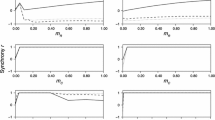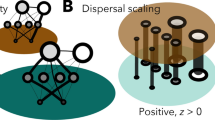Summary
We compared the metapopulation dynamics of predator—prey systems with (1) adaptive global dispersal, (2) adaptive local dispersal, (3) fixed global dispersal and (4) fixed local dispersal by predators. Adaptive dispersal was modelled using the marginal value theorem, such that predators departed patches when the instantaneous rate of prey capture was less than the long-term rate of prey capture averaged over all patches, scaled to the movement time between patches. Adaptive dispersal tended to stabilize metapopulation dynamics in a similar manner to conventional fixed dispersal models, but the temporal dynamics of adaptive dispersal models were more unpredictable than the smooth oscillations of fixed dispersal models. Moreover, fixed and adaptive dispersal models responded differently to spatial variation in patch productivity and the degree of compartmentalization of the system. For both adaptive dispersal and fixed dispersal models, localized (‘stepping-stone’) dispersal was more strongly stabilizing than global (‘island’) dispersal. Variation among predators in the probability of dispersal in relation to local prey density had a strong stabilizing influence on both within-patch and metapopulation dynamics. These results suggest that adaptive space use strategies by predators could have important implications for the dynamics of spatially heterogeneous trophic systems.
Similar content being viewed by others
References
Abramsky, Z., Rosenzweig, M.L. and Pinshow, B. (1991) The shape of a gerbil isocline: an experimental field study using principles of optimal habitat selection.Ecology 72, 328–40.
Arditi, R. and D'Acorogna, B. (1988) Optimal foraging on arbitrary food distributions and the definition of habitat patches.Am. Nat. 131, 837–46.
Bernstein, C., Kacelnik, A. and Krebs, J.R. (1991) Individual decisions and the distribution of predators in a patchy environment. II. The influence of travel costs and structure of the environment.J. Anim. Ecol. 60, 205–25.
Carpenter, S.R., Kitchell, J.F. and Hodgson, J.R. (1985) Cascading trophic interactions and lake productivity.Bioscience 35, 634–9.
Charnov, E.L. (1976) Optimal foraging, the marginal value theorem.Theor. Pop. Biol. 9, 129–36.
Chesson, P.L. and Murdoch, W.W. (1986) Aggregation of risk: relationships among host—parasitoid models.Am. Nat. 127, 696–715.
Comins, H.N. and Blatt, D.W.E. (1974) Prey—predator models in spatially heterogeneous environments.J. Theor. Biol. 48, 75–83.
Crowley, P.H. (1981) Dispersal and the stability of predator—prey interactions.Am. Nat. 118, 673–701.
Fretwell, S.D. (1977) The regulation of plant communities by the food chains exploiting them.Perspect. Biol. Med. 20, 169–85.
Fretwell, S.D. and Lucas, H.L. (1970) On territorial behavior and other factors influencing habitat distribution in birds. I. Theoretical development.Acta Biotheor. 19, 16–36.
Hassell, M.P. and Pacala, S.W. (1990) Heterogeneity and the dynamics of host—parasitoid interactions.Phil. Trans. Royal Soc. Lond. (series B) 330, 203–20.
Hassell, M.P., Comins, H.N. and May, R.M. (1991) Spatial structure and chaos in insect population dynamics.Nature 353, 255–8.
Hastings, A. (1977) Spatial heterogeneity and the stability of predator—prey systems.Theor. Pop. Biol. 12, 37–48.
Hilborn, R. (1975). The effect of spatial heterogeneity on the persistence of predator—prey interactions.Theor. Pop. Biol. 8, 346–55.
Kareiva, P. (1990) Population dynamics in spatially complex environments: theory and data.Phil. Trans. R. Soc. Lond. (series B) 330, 175–90.
May, R.M. (1972) Limit cycles in predator—prey communities.Science 177, 900–2.
May, R.M. (1978) Host—parasitoid systems in patchy environments: a phenomenological model.J. Anim. Ecol. 47, 833–43.
Maynard-Smith, J. (1974)Models in Ecology. Cambridge University Press, Cambridge, UK.
McNair, J.N. (1986) The effects of refuges on predator—prey interactions: a reconsideration.Theor. Pop. Biol. 29, 38–63.
Mimura, M, and Murray, J.D. (1978) On a diffusive prey—predator model which exhibits patchiness.J. Theor. Biol. 75, 249–62.
Murdoch, W.W. (1977) Stabilizing effects of spatial heterogeneity in predator—prey systems.Theor. Pop. Biol. 11, 252–73.
Murdoch, W.W. and Oaten, E. (1975) Predation and population stability.Adv. Ecol. Res. 9, 2–131.
Nachman, G. (1987) Systems analysis of acarine predator—prey interactions. II. The role of spatial processes in system stability.J. Anim. Ecol. 56, 267–81.
Oksanen, L. (1983). Trophic exploitation and arctic phytomass patterns.Am. Nat. 122, 45–52.
Oksanen, L., Fretwell, S.D., Arruda, J. and Niemälä, P. (1981) Exploitation ecosystems in gradients of primary productivity.Am. Nat. 118, 240–61.
Pacala, S.W., Hassell, M.P. and May, R.M. (1990) Host—parasitoid associations in patchy environments.Nature 344, 150–3.
Press, W.H., Flannery, B.P., Teukolsky, S.A. and Vetterling, W.T. (1988)Numerical Recipes in C. Cambridge University Press, Cambridge, UK.
Pulliam, H.R. (1988) Sources, sinks, and population regulation.Am. Nat. 132, 652–61.
Pulliam, H.R. and Danielson, B.J. (1991) Sources, sinks, and habitat selection: a landscape perspective on population dynamics.Am. Nat. 137, S50–66.
Reeve, J.D. (1988) Environmental variability, migration, and persistence in host—parasitoid systems.Am. Nat. 132, 810–36.
Roff, D.A. (1974) The analysis of a population model demonstrating the importance of dispersal in a heterogeneous environment.Oecologia (Berlin) 15, 259–75.
Rosenzweig, M.L. and MacArthur, R.H. (1963) Graphical representation and stability conditions of predator—prey interactions.Am. Nat. 97, 209–23.
Rosenzweig, M.L. (1971) Paradox of enrichment, destabilization of exploitation ecosystems in ecological time.Science 171, 385–7.
Rosenzweig, M.L. (1981) A theory of habitat selection.Ecology 62, 327–35.
Rosenzweig, M.L. (1986) Hummingbird isolegs in an experimental system.Behav. Ecol. Sociobiol. 19, 313–22.
Rosenzweig, M.L. (1991) Habitat selection and population interactions: the search for mechanism.Am. Nat. 137, S5–28.
Schmitz, O.J. (1992) Exploitation in model food chains with mechanistic consumer—resource dynamics.Theor. Pop. Biol. 41, 161–83.
Sih, A. (1987) Prey refuges and predator—prey stability.Theor. Pop. Biol. 31, 1–12.
Stephens, D.W. and Krebs, J.R. (1986)Foraging Theory. Princeton University Press, Princeton, USA.
Tanner, J.T. (1975) The stability and the intrinsic growth rates of prey and predator populations.Ecology 56, 855–67.
Taylor, A.D. (1988) Large-scale spatial structure and population dynamics in arthropod predator—prey systems.Ann. Zool. Fenn. 25, 63–74.
Turchin, P. (1989) Population consequences of aggregative movement.J. Anim. Ecol. 58, 75–100.
Ziegler, B.P. (1977) Persistence and patchiness of predator—prey systems induced by discrete event population exchange mechanisms.J. Theor. Biol. 67, 687–713.
Author information
Authors and Affiliations
Rights and permissions
About this article
Cite this article
Fryxell, J.M., Lundberg, P. Optimal patch use and metapopulation dynamics. Evol Ecol 7, 379–393 (1993). https://doi.org/10.1007/BF01237869
Issue Date:
DOI: https://doi.org/10.1007/BF01237869




